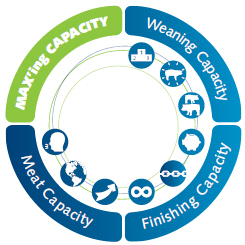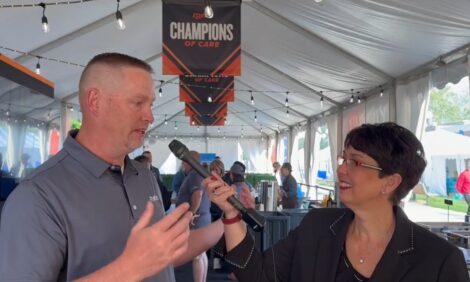



MAX'ing Weaning Capacity with Key Success Factor: Solid Sow Performance - 2
Solid Sow Performance is influenced by three main factors: retention rate, sow productive lifetime and 'stayability'. In this article, you can read Lanny Ziola's expert vision on increasing profitability with focus on sow productive lifetime.
Increase total system profitability with MAX'ing Capacity
It is Hypor's philosophy that focuses on the bottom line result, linking the factors that influence the entire pork value chain.
MAX'ing Capacity is divided into three pillars that cover the chain: Weaning Capacity, Finishing Capacity and Meat Capacity. For every pillar, there are three key success factors with three articles each that concentrate on how to improve.
Sow Productive Lifetime: Part of Solid Sow Performance

Job title: Technical Service Representative
Experience: 5 years
Drive: Always learning from others and developing my own experience
Best achievement: Assisting with and implementing ultrasound scanning procedures throughout Hypor and with customers around the world.
Life slogan: We make a living by what we get, we make a life by what we give.
Future: Genomic selection will have a profound impact on the swine breeding industry. Consolidation of the business will be inevitable as the number of genetic companies who can wield such a powerful tool is not large. Efficient production will be the goal for all food supply chains and providing the customer with technical knowledge and expertise to achieve that goal will determine who wins at the end of the day.
Sow Productive Lifetime refers to the length of time a sow remains productive
before she exits the herd. Health, nutrition, environment, management and
genetics can all play a role in the productive life of a sow. Some lines are known
for robustness, while others are much more vulnerable to environmental challenges.
MAX'ing Capacity comes down to getting the full genetic potential for your
environment and making the best decisions to maximise profitability. Together
with Stayability and Retention Rate, you will have a Solid Sow Performance.
A sow's contribution to total system profitability is defined by a consistent high
output of full value piglets per year over a large as possible productive lifetime.
Sow Productive Lifetime is a rather good total profit indicator for an individual sow
and can be measured relatively easy. As a trait, Sow Productive Lifetime focuses on
the cumulative number of piglets a sow has weaned by the time of her removal. A sow that remains productive in the breeding herd for a longer period of time is
likely to wean more piglets in her lifetime than a sow that is only able to stay in the
herd for a couple of parities. Thus older sows are more likely to recoup the initial
cost of gilt development. Dr Ken Stalder at Iowa State University suggests that for
average US farrow-to-finish operations, a sow needs to reach third parity before
becoming profitable (2009). Average parity of removed sows may imply the level
of profitability for a hog operation, although true economic value is attained when
a sow weans as many full value piglets per litter as possible, repeatedly, without recycling,
over multiple parities.
Sow Productive Lifetime is directly impacted by removal rates, fertility and Weaning
Capacity. The most significant factors related to culling decision include reproductive
failure, poor performance and locomotive degeneration (Serenius & Stalder,
2006). Gilts and first parity animals are especially susceptible to reproductive and
performance problems. Age at first mating or first oestrus is an important trait in the
breeding goal to make sure that gilts start cycling early and get bred by their third
heat. Effective isolation and vaccination strategies, timing of boar exposure, heat
detection and weight at first mating are critical aspects for gilt development and
entry into the herd. Coming into oestrus and the ability to come into oestrus after
their first litter is weaned (with minimised probability of a second parity drop) are
both traits with high heritabilities (approx. 0.15-0.20). These traits should be part of
a modern breeding programme.
Hypor recommends targeting gilts to start mating at approximately 210 days of age
and at least 135kg (297.62 lbs). At this time in the gilt's life, she is sexually mature
and biologically prepared for pregnancy, having had at least one previous oestrus
cycle. Gilts should start to receive boar exposure at about 180 days of age and be
bred upon the second or even third oestrus.
Providing the nutritional requirements that help sows through the rigours of
farrowing and lactation is also important. Overfeeding gestating sows can limit feed
intake at farrowing, resulting in excessive weight loss during lactation. Also starting
too early with lactation feed - more than seven days before farrowing - will have
similar negative impact on feed intake and milk production. The sow may become
a poor milker and/or lose a significant amount of weight, resulting in reduced
reproductive performance in subsequent parities. A female that maintains good
body condition after weaning will rebreed more quickly and contribute to large
robust litters. In this way, it will be easier to maintain a healthy breeding herd with
reduced incidence of injuries such as shoulder sores. With the increasing attention to
welfare, these are important considerations for a sustainable breeding programme.
Good lactation performance at parity one has been shown to have a positive
impact on prolificacy in subsequent parities. Farmer et al. (2012) showed that teats
that were suckled in first lactation produce more milk and develop better in the
second lactation than non-suckled teats. So for healthy udder development and
maximized milk production, it appears desirable to start milking all functional teats
in parity one. In order to be a good milker, the female should have a well-developed
underline, having at least 14 but preferably 16 or more evenly spaced teats. Hypor
recommends loading up gilts with as many as 12 to 14 piglets in their first parity;
this contributes to udder and milk gland development, and has a positive impact
on weaning ability in subsequent parities. Increased milk production appears to
stimulate a sow's feed intake, preventing catabolism when managed properly.
Structural/locomotive culls are most prevalent in sows up to parity three. Sows
that have significant feet and leg problems will most likely exit the herd before the
third parity. As a female ages and becomes heavier, stress is placed on the feet and
legs of the animal. High growth rates and overfeeding can further compound the
issue. Poor leg quality can result in locomotive problems, which can affect the ability
of the animal to stand during heat or limit the animal's access to feed and water.
This underscores the importance of selecting replacement gilts with good structural
soundness.
In modern breeding programmes, traits like 'stayability' or longevity are part of the
breeding goal. Hypor's goal is to increase the percentage of sows that are able to
stay productive to the fourth parity. Together with focus on improved Weaning
Capacity, this leads to a breeding stock that is better able to generate profit under
commercial circumstances. The biggest challenge for a sow is to wean large litters
and to get rebred quickly in the second parity. Failure to cycle or conceive and
second parity drop are common issues which lead to culling in the early part of their
productive life. Sows bred for stayability to fourth parity are typically well-prepared
to overcome these challenges.
As a breeding company, Hypor is focused on genetic improvement. The speed
of genetic improvement is maximised through high levels of breeding stock
replacement at the genetic nucleus level. Younger animals are presumably
genetically superior to the generations that came before them. This results in sows
being consciously removed from the herd before they reach maximum productivity.
How then, does Hypor select for Sow Productive Lifetime? A large amount of data
comes from in-house breeding systems and multiplication systems where offspring
of nucleus boars remain in the herd to higher parities. This data provides sufficient
accuracy for our breeding value for stayability to fourth parity. Apart from direct
selection through stayability, there is also indirect selection for a vast number of
traits that are the base of improved sow longevity. The company's selection index includes
traits such as age at first mating, wean-to-first-service interval, number of piglets
born, percentage of piglets born alive, pre- and post-weaning mortality, feet and
leg scores, etc. In its breeding programme, Hypor focuses on balancing longevity and
performance leading to maximised profit and optimised efficiency.
Sow Productive Lifetime is a good measurement for and contribution to Solid
Sow Performance. This one of three key success factors improves your Weaning
Capacity and total system profitability. Awareness of the importance of a prolonged
productive life of sows will have direct impact on choice and selection of breeding
stock and gilt and sow management decisions. It will lead to immediate, short-term
productivity benefits and will directly help improve return on genetic investment
over the long-run. MAX'ing Capacity is about knowing were to increase profitability.
Read Retention Rate and Stayability online for the complete overview to achieve
Solid Sow Performance.
At www.hypor.com/maxing, you can find all articles and
with those, you can maximise your capacity.
References
- Farmer C., Palin M.F., Theil P.K., Sorensen M. T. and Devillers N. 2012. Milk production in sows from a teat in second parity is influenced by whether it was suckled in first parity. Journal of Animal Science. doi:10.2527/jas.2012-5127
- Serenius, T. and Stalder, K.J. 2006. Selection for sow longevity. Journal of Animal Science, 84:E166-E171
- Stalder K.J. 2009. Calculating payback parity for replacement gilts. National Hog Farmer.

Further ReadingYou can view the previous article in this series from Hypor by clicking here. |
October 2012







